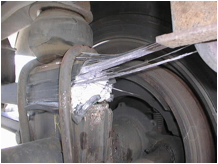Tanker Trailer Suspension Failure
 Figure 1. Remains of right rear leaf spring
|
A gasoline tanker truck and trailer was making its way along a mountain highway, negotiating one of the many curves, when it suddenly rolled onto its left side spilling most of its contents onto the road and into an adjacent stream. No one was hurt in the solo accident, but the cleanup costs were very high. Should the trucking company bear the brunt of these costs, or were there other mitigating factors that contributed to the accident?
An inspection of the truck and trailer after the accident revealed that the right rear suspension leaf spring on the trailer was broken in half; the remains of the leaf spring on the trailer are shown in Figure 1. The rear part of the spring was broken completely off, and was found several hundred feet up the road from the rollover. The leaf springs on this trailer were made of a glass reinforced epoxy composite (fiberglass). Historically trailer springs such as these have been made of steel, but the industry is always on the lookout for lighter weight trailer components. The tradeoff with weight savings however is that the fiberglass springs lose their stiffness (range of travel) faster than their steel counterparts and must be replaced more frequently. This spring saw only 6 months of service before its failure; far less than the four year life usually achieved on similar springs in service.
An inspection of the spring found that cracking along its length had also occurred even in areas remote from the fracture. The spring was cut open in one of these areas and microscopic examination here revealed that the spring did not fail all at once. It had been suffering from progressive damage for some period of time prior to the accident. Figure 2 is a 14,000 times magnification of an area on the opposite side of the spring where the fracture occurred. The trough seen in the figure is where a glass fiber had been adhered, and the hackle marks are signs of progressive separation over time of the glass fiber from the epoxy matrix. Because the spring showed signs of progressive damage, it had likely lost most of its stiffness long before the accident occurred.

